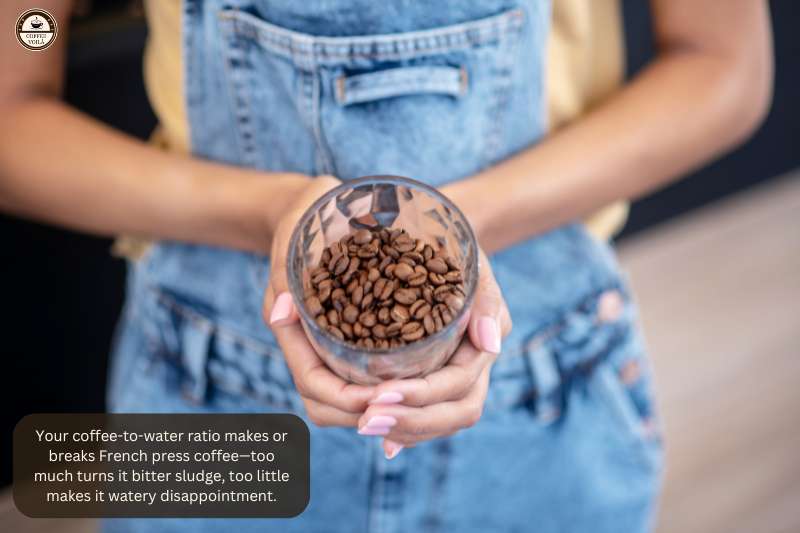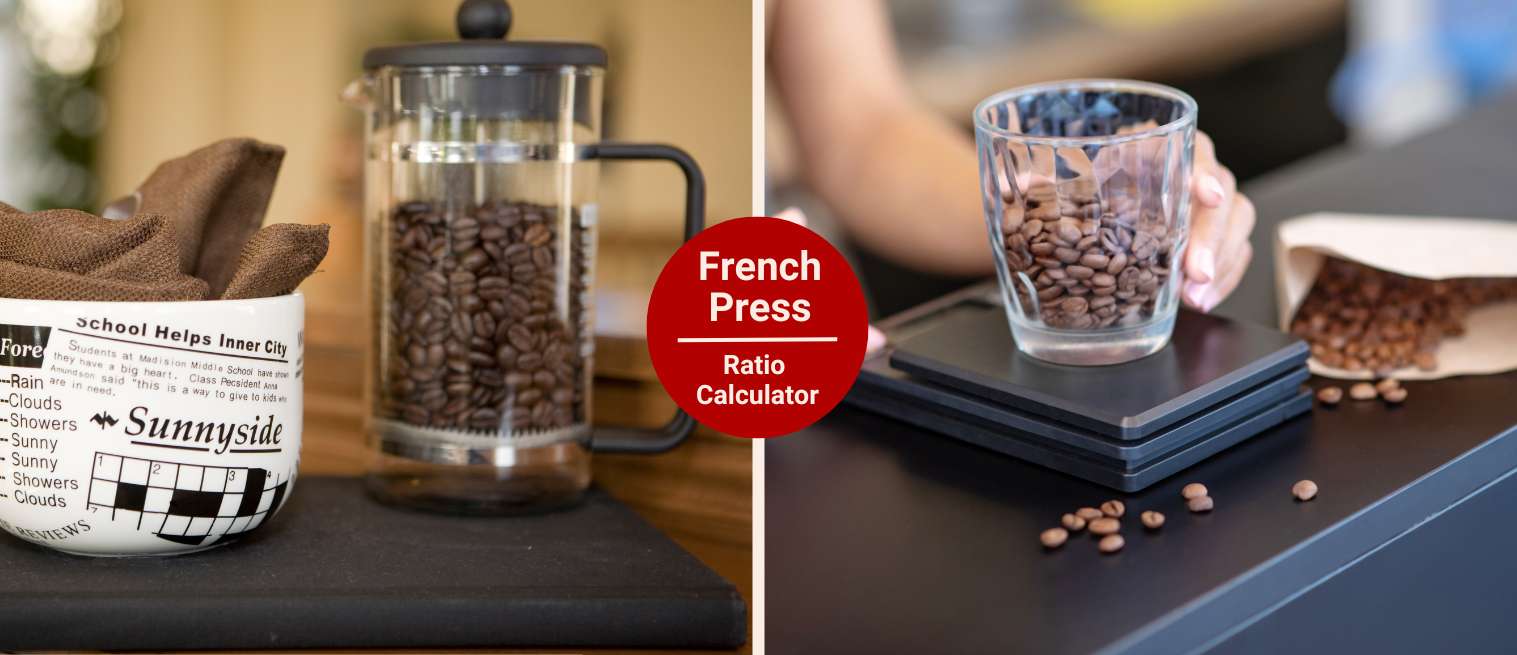French Press Coffee to Water Ratio Calculator (Perfect Brew Guide)
You know what used to drive me crazy? Back in the day, I only had this old kitchen scale that barely registered small amounts.
Anything under 10 grams? Forget it! It only blinked at me like, “good luck, buddy.” So when it came to brewing French press coffee, I’d scoop, guess, and pray the ratio wasn’t totally off.
Some mornings it worked. Other mornings… watery disappointment or sludge city.
That’s the problem without the right ratio, your French press can swing from too weak to way too strong, and you never know what you’re going to sip. And honestly, that unpredictability takes all the joy out of the process.
Here’s the solution: a simple coffee-to-water ratio calculator that does the math for you.
In this post, I’ll show you the standard ratios (and how roast level changes them), give you a free calculator to nail your measurements, and walk you through step-by-step brewing so your cup comes out balanced every single time.
Why the Coffee-to-Water Ratio Matters
Here’s the thing: your coffee-to-water ratio is everything. It’s the line between a cup that tastes like liquid tar and one that’s smooth enough to sip without making a face.
Add too much coffee and you’ll get a brew that’s bitter, over-extracted, and even a little gritty on the tongue. I remember trying a 1:10 ratio once (because in my head, “stronger = better”).

Guess what? Big mistake. I couldn’t even finish half the mug. It felt like I was drinking a burnt smoothie.
Go the other way and use too little coffee, and you’ll wind up with a sad, watery drink that tastes like hot water with some coffee bean flavoring. Both extremes? A total waste of good beans.
So, what’s the sweet spot?
The right ratio gives you that bold, rounded flavor without the harsh bite. It’s why baristas can hand you a cup that tastes spot-on every single time.
For French press, my go-to is the classic 1:15 ratio (one part coffee to fifteen parts water). That’s the balanced, café-style brew most people love. But here’s a closer look:
| Ratio | Flavor Profile | What to Expect |
|---|---|---|
| 1:12 (Strong) | Bold & intense | Syrupy, thick body, great if you like milk or cream in your coffee |
| 1:15 (Balanced) | Classic café-style | Rounded, smooth flavor with good body and clarity |
| 1:17 (Smooth) | Lighter & cleaner | Less bitter, more tea-like clarity, highlights subtle notes |
Don’t forget the roast factor
Roast levels change the game too. For instance, light roasts are dense and less soluble, so they often need a little more coffee to shine. On the other hand, dark roasts are fragile. I mean, you push them too far, and bitterness barges in fast.
Coffee-to-Water Ratio Calculator
If you’ve ever found yourself staring at your French press, wondering “How many scoops should I actually put in here?”, you’re not alone.
I know ratios can feel like math class until you have a simple calculator doing the work for you. That’s why I built this little tool you can drop right into your site.
French Press Ratio Calculator
Pick your brew size and strength. The calculator adjusts for roast level and returns exact doses.
Your Brew Plan
Approximation: 1 level tablespoon of coarse grounds ≈ 7 g. Weighing is always most accurate.How this calculator works
How does it work?
It’s simple. You want to add:
- Your press size or servings. Say you’re making 500 ml (a medium French press) or just enough for one mug.
- Your preferred strength. Strong (1:12) for that bold, heavy-bodied cup, balanced (1:15) for the classic café style, or smooth (1:17) if you like something closer to tea-like clarity.
- Roast level adjustments. Light roasts are denser and less soluble, so give them about 5% more coffee. Dark roasts are more delicate. I suggest using about 5% less to avoid the bitterness hitting you too hard.
The calculator then spits out your dose in grams, ounces, and tablespoons (for the “I don’t own a scale yet” crowd). I’ve tested it against my own brews, such as a 500 ml batch at 1:15, which comes out to ~33 g of coffee and it nails it every time.
Step-by-Step Brewing with Correct Ratios
Ratios on paper are one thing, but seeing how they play out in an actual brew makes all the difference. So, let’s walk through the process together:
Step 1) Measure Your Beans
For years I used scoops and spoons because it felt “close enough.” The problem is, one scoop of light roast can weigh way more than the same scoop of dark roast.
That means your brew strength swings wildly. A simple kitchen scale fixes this. For example, if you’re brewing 500 ml at a 1:15 ratio, you’ll need 33 g of coffee. This keeps your flavor consistent every single time.
Step 2) Grind Coarsely
French press calls for a grind that looks and feels like breadcrumbs. I once ignored this and ground my beans closer to espresso size. And let’s just say the plunge felt like pushing through wet cement, and the taste? Pure mud. Get it right and you’ll notice a fuller body with way less grit.
Step 3) Heat the Water to 195–205°F (90–96°C)
If you don’t own a thermometer, don’t worry, just bring water to a boil, then let it sit for about 30 seconds.
Step 4) Add Coffee + Water, Stir, and Bloom for 30 Seconds
When hot water first hits the grounds, you’ll see bubbles rise up and smell that first wave of rich, roasty aroma. That’s trapped CO₂ escaping. You want to stir it once or twice to make sure all the grounds are wet.
Step 5) Steep for 4 Minutes
Four minutes feels like forever when you’re craving caffeine, but it’s worth it. This is enough time to extract sweetness and body without that bitterness taking over.
Step 6) Plunge Slowly and Serve Immediately
If you slam the plunger down, fines sneak past the filter and stir up extra sediment. Slow and steady gives you a cleaner cup.
Last Thoughts
So now I’m curious: what’s your go-to ratio, and do you tweak it depending on roast or mood? Have you found your “golden” French press formula yet or are you still experimenting?
Either way, keep brewing, keep tasting, and before long your mornings will feel smoother, richer, and perfectly balanced. Voilà.







